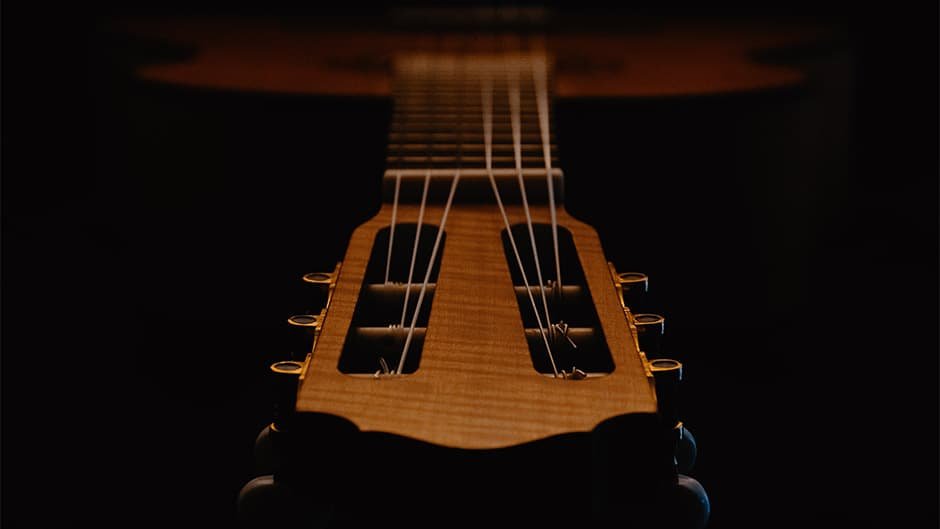I have lived in dry regions as well as very wet (humid) regions. And I have lugged my guitar along wherever I lived. So I have researched humidity related problems in some detail and how they affect our beloved, and essentially wooden, instrument of choice.
Why does a classical guitar need a humidifier? In extremely dry areas, or moderately humid areas which turn dry in winter, a humidifier supplies additional moisture to compensate. In very humid areas, a de-humidifier removes excess moisture from affecting the wood. A 2-way humidifier does both the jobs as needed, depending on ambient moisture levels.
Buying the latest humidifier from a list found on the internet is not much of a solution. Understanding the basics of how humidity in your region affects your instrument is what counts. A single product may not help. Depending on your location, your home environment and your travels, you may need a combination of treatments.
It’s bad news at the extremes
Most good quality classical guitars are put together in factories with a humidity level of around 50%. So once it moves out of that controlled environment, it is vulnerable – especially in dry, low levels below 40%.
The humidity ‘neutral’ we aim for is 50% because that feels like home to a guitar. Like with most things in real life, what’s of practical value is a range of numbers rather than a single number. If your classical guitar is maintained at the 45% to 55% humidity level, you’d be fine.
Adding some common sense, we can expand the range. Anything between 40% to 65% humidity level (called RH, relative humidity) if maintained for most of the year should see you through. It is the extremes that cause damage – humidity levels below 40% over a sustained period and levels over 65% over a sustained period.
I’ve read an article by a respected luthier who said he got panic calls from customers each winter, unfailingly, about their soundboards or backs showing a crack.

These can be fixed most of the time without lasting damage. That’s hardly the point, though. The stress on seeing a crack on one’s guitar, especially an expensive, luthier-made one, can be painful enough.
Allow this to sink: At too low a humidity level, your classical guitar will crack or shrink.
When the humidity levels get too high – over 65% or 70% – the wood expands with the additional moisture. A swollen piece of wood makes a dull, tubby sound. Besides shortening the life of a good guitar.
All told, it is correct to say that extreme dryness is more dangerous to the guitar (cracking, warping, shrinking) than extreme wetness (swelling, breaking of glue joints). Neither is a pretty outcome.
Step One: Get a hygrometer to neutralize your city
Where do you live? The answer to that is everything. Here’s a list of all the states of the USA showing RH (Relative Humidity) levels as an annual percentage.
You can check specifically for your city’s RH number (anywhere in the world, not just the USA) by googling ‘Amsterdam relative humidity level’ if that’s where you live.
Here’s the list arranged from the very dry states (low RH) to the very moist (high RH).
List of average RH levels in the USA
| State | Average RH (%) |
| Nevada | 38 |
| Arizona | 39 |
| New Mexico | 46 |
| Utah | 52 |
| Colorado | 54 |
| Wyoming | 57 |
| Montana | 60 |
| California | 61 |
| Idaho | 62 |
| Oklahoma | 64 |
| Texas | 65 |
| Nebraska | 66 |
| Kansas | 66 |
| South Dakota | 67 |
| Missouri | 69 |
| Connecticut | 69 |
| South Carolina | 69 |
| Maryland | 69 |
| Virginia | 69 |
| Oregon | 69 |
| New Jersey | 69 |
| North Carolina | 70 |
| New Hampshire | 70 |
| Minnesota | 70 |
| Kentucky | 70 |
| West Virginia | 70 |
| Pennsylvania | 70 |
| Tennessee | 70 |
| Massachusetts | 71 |
| Georgia | 71 |
| Illinois | 71 |
| North Dakota | 71 |
| Arkansas | 71 |
| Delaware | 71 |
| New York | 71 |
| Iowa | 72 |
| Michigan | 72 |
| Indiana | 72 |
| Vermont | 72 |
| Maine | 72 |
| Wisconsin | 72 |
| Alabama | 72 |
| Ohio | 72 |
| Washington | 72 |
| Rhode Island | 72 |
| Hawaii | 73 |
| Louisiana | 74 |
| Mississippi | 74 |
| Florida | 75 |
| Alaska | 77 |
Remember these are average levels. In winter you’d expect the numbers to be lower. It’s time to look at especially the top few of the list and whistle softly to yourself. You’d better do something!
Instead of sticking little packets and tubes into the guitar soundhole, you may take a more holistic approach: Battle your city first. You will want to purchase a hygrometer for your home or at least the music room. It costs nothing much, especially the simple (but detailed) digital one.
For instance, something like the inexpensive ThermoPro TP50 Digital Hygrometer (Amazon link) gives you control – and true understanding over time – of your environment. It helps in figuring out solutions that are relevant and informed.
Let your hygrometer be your guide. If it reads 45% or more do NOT use a humidifier of any kind. Your guitar is fine as it is. There is such a thing as over humidification and you want to avoid that.
Step Two: Humidify your home and guitar
Two top-level humidifying solutions can be considered now for folks who live in dryness prone areas and also practice for a few hours every day.
Humidify your home or at least your practice room with a room humidifier. There are many to be found online and in department stores. A room humidifier ensures a fixed and almost permanent solution to a dry humidity problem that can go on for weeks and months.
The basic concept is simple: a room humidifier introduces water vapor in the air, which is exactly what we need.
Here are a couple of popular options – affiliate Amazon links to a room humidifier:
The larger capacity (6L) for a large room: Miroco Cool Mist Humidifier and the smaller (1.5L) Pure Enrichment MistAire Ultrasonic Cool Mist Humidifier.
If you don’t want to humidify an entire room or house, you can humidify your guitar case instead. A solution like Humicase is quite good. It is a well constructed guitar case for classical guitars with humidity control built right into it. Considering you can spend hundreds of dollars on a guitar case, this isn’t really expensive.
Check the price of Humicase at Amazon.
A Humicase keeps the guitar well humidified. Needless to say, you must remember to return the guitar to its case (and latch it up) after each playing session. You can’t afford to skip this discipline.
With either a room humidifier or a Humicase in place, it makes sense to follow basic precautions:
- Avoid placing the guitar next to a heat source such as a radiator. The guitar can crack
- Even in areas of higher humidity, use of air-conditioning can make the air dry
- Never leave the guitar in damp places or near the bathroom. It can swell up with moisture
- In rooms prone to too much dryness or damp it’s not good to leave the guitar exposed or hanging from a wall hook. It must be in a (humidified) case
- If using a room humidifier, don’t place the guitar next to it to avoid over humidification
- Switch off the room humidifier if the RH in the room rises over 45%
If your home is not in a region that is extremely dry you can adopt a milder solution.
Instead of a semi-permanent installation like a room humidifier or investing in a Humicase that keeps on humidifying, you can drop a packet or two of Oasis Guitar Humidifier OH-5 Plus or D’Addario Humidipak Automatic Humidity Control System into the guitar case.
This can be done on an as-required basis which may suit certain regions that have dry spells mainly during winter.
The D’Addario Humidipak is a pretty neat 2-way system in that it not only humidifies but also removes excess moisture inside the guitar case if the humidity levels go up. It is also easy to use. It’s a matter of replacing the packs when the fluids go dry. Nothing to top up or fill in.
There are a lot of choices both online and in guitar stores for guitar humidifiers. There’s a product called Boveda For Music (which I hear is the same product as the D’Addario 2-way system) which too will get the job done and will last a few months in the case. It is a 2-way system and comes in a pack of 12 and used to be simply called Boveda 49 a while ago.
(Incidentally, the 49 in the name ‘Boveda 49’ refers to the RH level it promises to maintain).
Check the price of the Boveda For Music at Amazon.
If your home is prone to excess humidity at least part of the year, it is easily tackled with the use of desiccants. Packs of either silica gel or bamboo charcoal are readily available in general stores and online. Dropping a couple of them in the guitar case should do the trick.
It’s good to remember that even in a region of high or adequate humidity levels, the use of an air-conditioner can render the air dry. So you will need some focussed humidifying from a Boveda pack or two in the case. Or a humidifier in the room.
Step Three: Humidify your travel
If you’re traveling to a region that is drier, you should take along your Humicase. Or, if you don’t have one, you can place your favorite humidifier pack (like the Boveda For Music) inside your regular guitar case.
I’m more inclined to do the latter in a situation like this, because I happen to have a hard case that is really handsome! It’s the one I got with my Amalio Burguet guitar, a fine specimen that I will never trade for a Humicase – or anything under the sun for that matter.
If traveling by car, it’s time to follow some common-sense precautions:
- Use a guitar case humidifier system especially when driving in dry weather
- The guitar case itself can be wrapped in a sealed cover or in cloth to keep in moisture
- Don’t keep the guitar and case in the trunk where hot and cold can fluctuate rapidly
- Don’t expose the guitar and case to direct sunlight on the back seat for a long time in a parked car
- If going into a heated room from freezing temperature outside, do not open the case too soon! Let the case come up to room temperature before taking the guitar out
- Avoid exposure to sudden changes in humidity or temperature from location to location
The more intermediate or advanced you get in your playing, the more of an investment there is to protect. Just knowing your immediate environment and choosing a couple of applicable products will guard your classical guitar for years.
And keep an eye on that hygrometer.
If you’re looking to build your repertoire from sheet music, read our review on free online resources to build your classical guitar repertoire.
Happy preserving!

